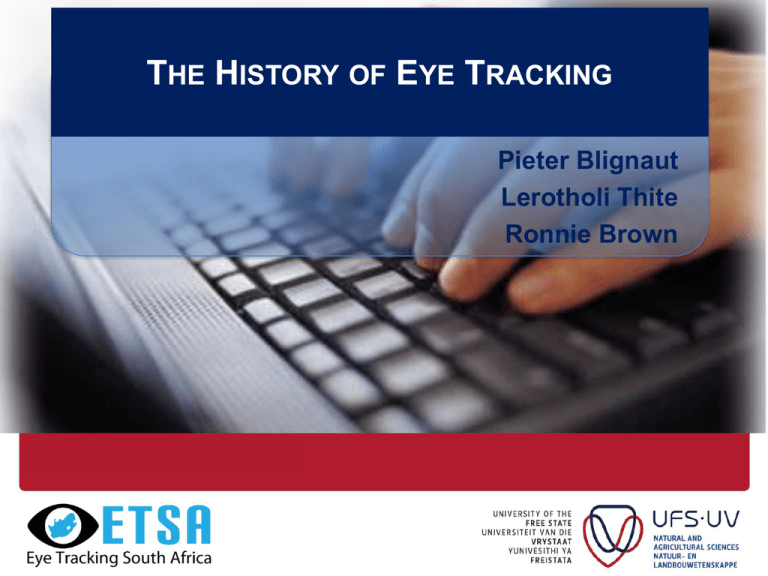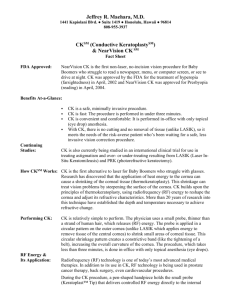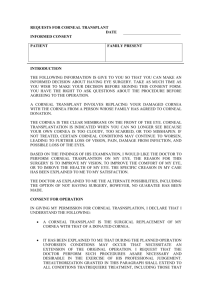History of eye tracking
advertisement

THE HISTORY OF EYE TRACKING Pieter Blignaut Lerotholi Thite Ronnie Brown RUBBER BANDS AND MIRRORS • 1792: Wells used after-images (aka ghost images). • 1878: Louis Emile Javal used a rubber band to mechanically couple an eye to an ear – thus magnifying the eye movement sound. • 1878: Javal used mirrors and saw eye movements as a series of jerks. These jerks were counted by placing a microphone on a closed eyelid as a subject read monocularly. Saccades were counted each time a bulge of the moving cornea bumped into the microphone. The French-originating term saccade was then introduced to describe the jerky movement of the eyes. LEVERS AND DRUMS • 1897/8: Recordings of eye movement started with Ahrens and Delabarre who fixed a small lever to the cornea. • 1898: Edmund Huey transferred the lever movement to a surface covered with a black powder on a rotating drum Edmund Huey • Huey discovered that no data is recorded during saccades but only during eye pauses (i.e. fixations). COVERING THE EYES • 1898: Delabarre attached a small moulded cap to the eye together with a wire running from the cap to a lever, which was able to draw horizontal movements of the eye on a smoked surface of a kymograph cylinder. A subject could then read text through a hole drilled in the cap. CORNEAL REFLECTION • When light is shone onto the eyes, it is reflected off the cornea, referred to as the Purkinje reflection. • The vector difference between the pupil centre and corneal reflection is mapped to gaze coordinates. CORNEAL REFLECTION • 1901: Dodge and Cline developed the first non-invasive eye tracker by using the reflection from a cornea. They used a falling photographic plate to record only horizontal eye position. The plate thus showed horizontal eye motion on the X-axis and time on the Y-axis. MOTION PICTURE PHOTOGRAPHY • 1905: Judd, McAllister and Steel introduced motion picture photography to record eye movement in two dimensions. A small white speck of material was inserted into a participant’s eye and its movement recorded. • 1920: Two-dimensional eye movement recording was achieved by recording head position by reflecting light off a pair of spectacles. • 1930: Miles Tinker applied the photographic technique in the study of eye movements during reading. Typeface, print size, page layout, etc. were varied to determine their effects on reading speed and eye movement patterns. • 1947: Paul Fitts and colleagues used motion picture cameras to study a pilot’s eye movement in cockpit control and other instruments during airplane landing. PHOTO-CHRONOGRAPHY • 1937 - The photochronograph technique by Dodge was further developed by Guy Thomas Buswell who also included head tracking. ELECTRO-OCULOGRAPHY • 1939: Jung used electro-oculography to do real-time processing of gaze data. Electrodes were attached to the skin close a participant’s eye. HEAD-MOUNTED TRACKERS • 1948: The first head-mounted eye tracker was invented by Hartridge and Thompson. • 1950: Norman Mackworth attached a camera on a helmet. • 1990: Land developed the first head-mounted eye tracker that could successfully be used outdoors for research studies. ALLOWING FREE HEAD MOVEMENT • 1958: Mackworth provided a visual scene to a participant and recorded resultant eye movement CONTACT LENSES • 1967: Yarbus, a Russian psychologist used a camera based system that involved tiny plane mirror attached to a surface of a contact lens and some illumination. Its reflection could then be recorded as a corneal reflection. SCLERAL COIL • A non-optical method used a scleral search coil, where a contact lens is embedded with a pair of orthogonal wire coils. These would trigger a magnetic field surrounding the subject’s head. MODERN DEVELOPMENTS • 1970s – Advent of the computer. Until then analysis was extremely painstaking. It was not uncommon to spend days processing data that took only minutes to collect. • 1984: Card did the first usability test using eye tracking. He was interested in how users search for commands in computer menus. MODERN EYE TRACKERS Thank you











